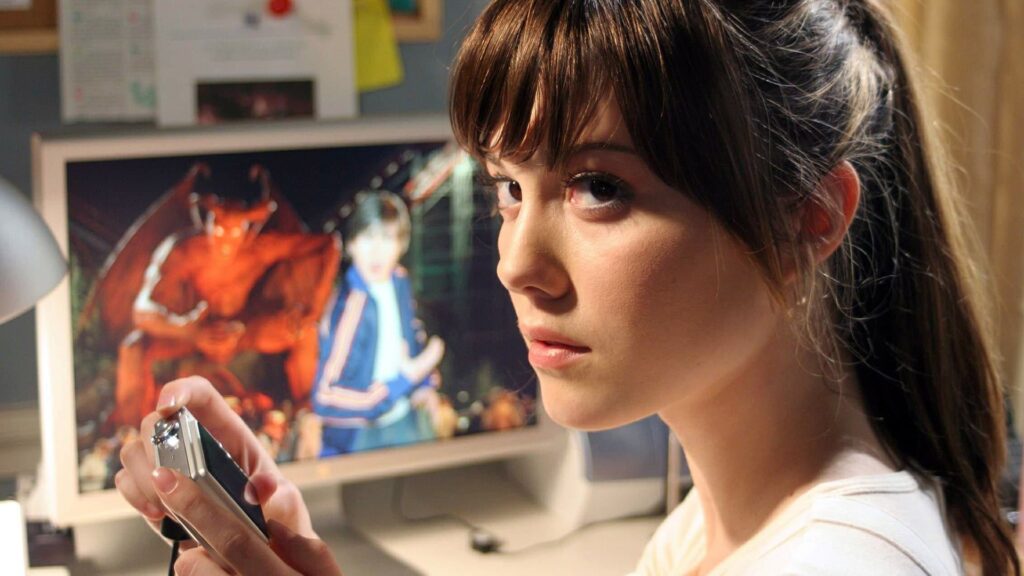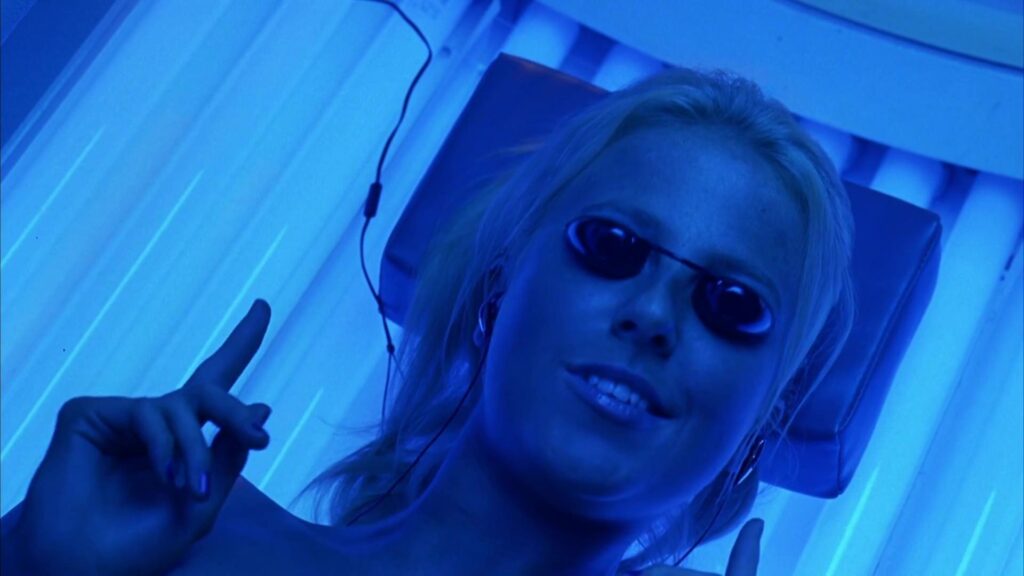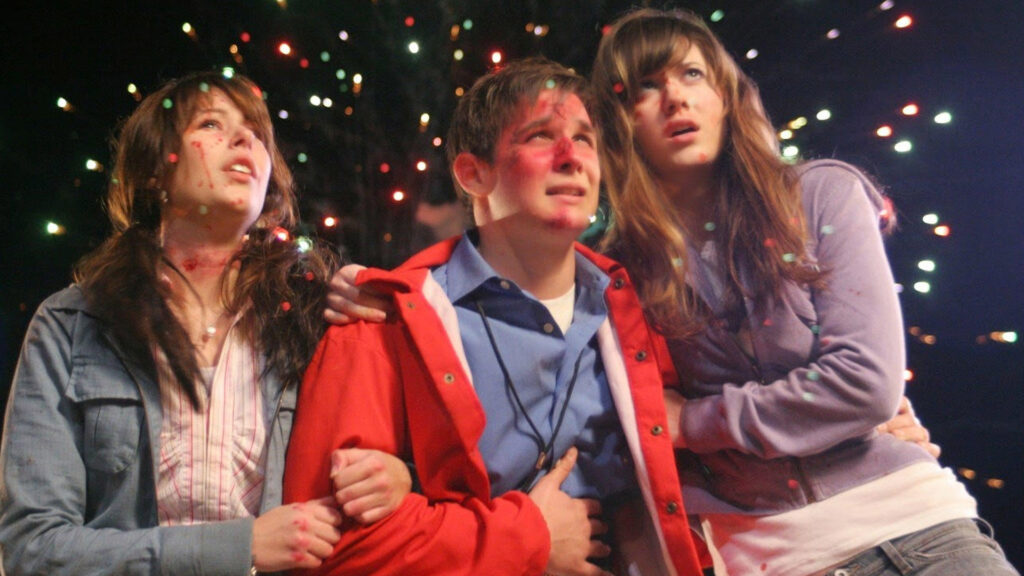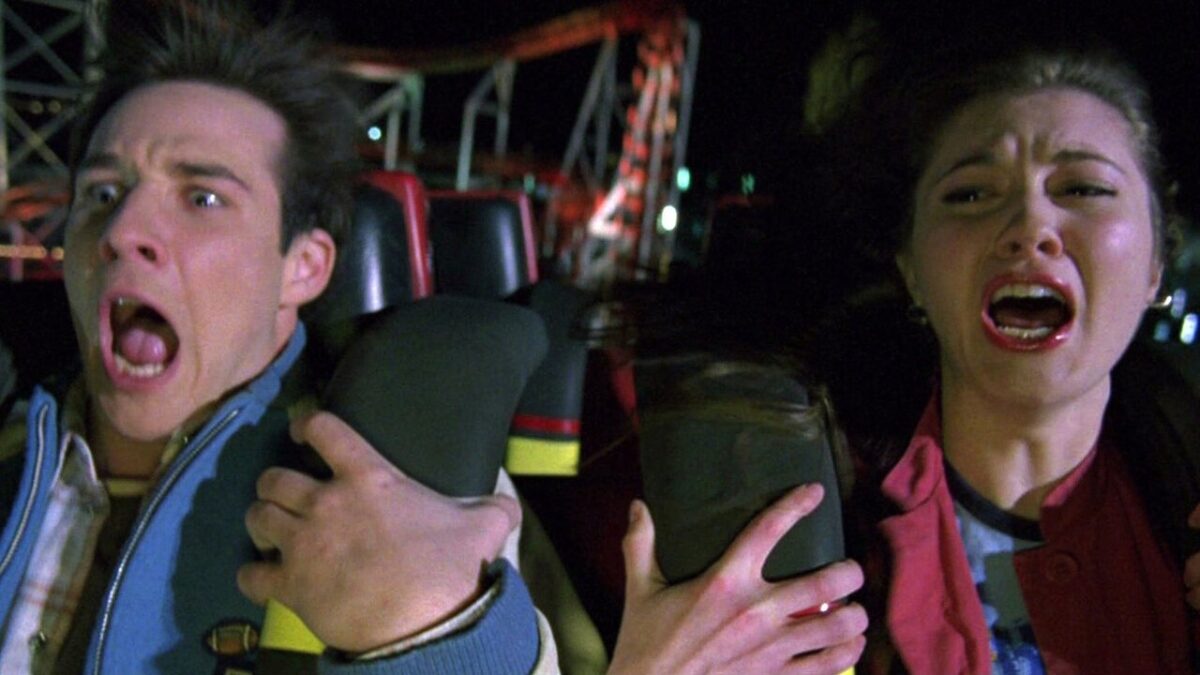A new foe has appeared!
Final Destination 3 has a few things going for it. First of all, it has a lead performance from Mary Elizabeth Winstead, a real-ass actor with chops and star power. Does it hurt that I’ve had a crush on her since I saw Live Free or Die Hard in 2007? No, it does not hurt. She tops Devon Sawa as the series’ best lead performance both in screen presence and in acting out an actual arc.
Second is, in fact, that arc, abbreviated though it is. Final Destination 3 reckons with an honest-to-God idea, at least in its first half. Whereas Final Destination laid the groundwork by having Alex (Sawa) ponder his own mortality (and perhaps subconsciously revel in others’), and Final Destination 2 had no ideas at all on its brain, Final Destination 3 considers survivor’s guilt. Winstead’s character Wendy failed to save her boyfriend after her premonition, and so she’s stuck blaming herself and revisiting the moment of his death on loop in her head. This is a very real experience; I used some of the exact reasoning and language that Wendy uses after my dad died in 2023. Alas, the movie mostly gives up on this idea at around the halfway point when it gets locked back into its death puzzle box, but it’s nice and actually pretty effective when it’s there.
But the third and biggest mark in its favor is that Final Destination 3 has excellent direction by James Wong, returning and improving upon his work from the opening entry. His knack for building tension has grown sharper, and he directs with visual verve and energy, making great use of the full widescreen frame. The film is shot in ‘scope, a first for the series, and it turns out to be a smart move: the extra width gives the elaborate death traps room to sprawl and breathe, making every normal object with a sharp end or a dangerous side effect feel like Chekhov’s gun on murderous steroids.

I also am fond of this film’s flavor. The creepy carnival vibe of the opening scene is a hoot, innocent images of merry-go-rounds and festival games and carnival decor cutting against looming dread. Harsh, artificial lighting adds some danger to the mood. It sets the “horror thrill ride” theme perfectly. The climactic return to a fireworks-laced summer fair ties the whole movie together thematically and tonally. In between, there are other images of suburban summer life: tanning, working out in the gym to get that beach bod, and a hardware store for those home improvement projects — all turned lethal.
With those strengths in mind, I was all ready about a half hour in to declare Final Destination 3 not just better than Part 2, but the best of the opening trilogy, which was originally envisioned as the series’ full breadth. Alas, it has a major flaw, and that’s that the death scenes and effects are just wildly uneven in execution. And when that’s the franchise’s calling card — the engine that drives the whole thing — that inconsistency puts a ceiling on the whole affair. Some kills land with perfect timing and black humor; others seem to lose their nerve in the edit bay or get muddled by unclear blocking. One even goes too far down the exploitation avenue. It’s the first film in the series that feels like it might have the yips about its own money shots.
The film opens with Wendy (Mary Elizabeth Winstead), high school student and yearbook photographer, heads to an amusement park with her classmates to celebrate their upcoming graduation. But before the Devil’s Flight roller coaster takes off, she has a horrifying vision of it derailing and killing everyone on board. She manages to panic her way off the ride, dragging along several classmates, including Kevin (Ryan Merriman), her boyfriend’s best friend, but fails to save her boyfriend and best friend, who are among the casualties when the vision comes true. As in Parts 1 and 2, the survivors subsequently begin dying in gruesome, Rube Goldbergian accidents. The twist this time is that Wendy realizes the photos she took at the amusement park contain cryptic clues to how each person will die. Teaming up with Kevin, she races to decipher the snapshots and try to avoid death a second time.
The photos-as-premonitions gimmick is more interesting than the confusing reverse-order twist of Part 2, at least in theory. It gives us more of a visual cue to the upcoming death, and gives the characters and viewers a chance to play detective as the scenes unfold. But, honestly, the movie doesn’t quite follow through. Wendy occasionally stares at a blurry shape in the background of a picture and gasps, but there’s rarely a real sense of deductive intrigue. It would’ve been more compelling if she played full-blown death detective, and the movie gets halfway there. But mostly we get a lot of “wait, does this shadow look like a nail gun?” followed by someone getting nail-gunned. It’s more window dressing than anything else.

As ever, the deaths are the main attraction, and Final Destination 3 gives us a full sampling platter, even if the flavors are uneven. Let’s go through them:
- The roller coaster disaster kicks things off with a bang, even if it takes its sweet time to get there. It’s a strong premonition sequence—visually busy in a good way, with lots of little cues to track and panic to build. My favorite moment is the coaster car stuck halfway up a loop-de-loop, a great “intrusive thought” scare. One curious twist (presumably a plot hole) this time around is that the cause of derailment seems to shift between vision and reality, as Frankie’s (Sam Easton) camera strap kicked off the derailment in the premonition, but he’s not on the coaster in the “real” timeline. So how did the coaster crash, then? Nonetheless, it delivers on the expected symphony of effects-driven violence and explosions of these opening segments, although not quite at the heights of Part 2’s highway pileup.
- Ashley (Chelan Simmons) and Ashlyn’s (Crystal Lowe) tanning bed flare-up is iconic for a reason: it’s the most visually memorable scene in the film. The juxtaposition of superficial beauty rituals and gruesome death is classic horror irony, and the scene milks it with agonizing detail. The death itself borders on too mean-spirited, especially as the film ogles their naked bodies (a first for the series). But the gradual buildup of absent-minded dangerous decisions is terrific. The match cut edit out of the scene to a pair of coffins is a big, dark laugh.
- Frankie’s death via car engine fan is subject to an odd bit of misdirection, as the camera doesn’t even reveal his presence in the scene before he dies. The scene includes some decent tension in the lead-up as Wendy and Kevin are trapped in the car trying to escape as they process they might be next, but it does seem like a half-hearted twist death. The actual gore effects are staged well but edited strangely, cutting away after barely a moment like they were trying to avoid the censors or something.
- Lewis’s (Texas Battle) weightlifting death is a standout. It turns a sweaty gym into a deathtrap. The way every piece of equipment becomes a potential killer is terrific. The payoff is a double-take joke-jump-scare that really lands.
- Erin’s (Alexz Johnson) hardware store nail gun massacre is probably the runner up to the tanning bed for most brutal in the film. I’m not sure the misdirection is 100% satisfying, though: You think it’s headed for cocky Ian (Kris Lemche), but Erin gets it quick and nasty.
- The climax is set at a 4th of July-esque summer festival and features multiple deaths and near-misses. We meet a character named Perry (Maggie Ma) a couple of seconds before she gets impaled by a flagpole, which is mostly a punchline murder as payoff for Wendy’s sister Julie (Amanda Crew) dodging death. But I really enjoyed the idea of Ian chasing down Wendy to try and kill her, essentially blaming her for death stalking the survivors down. His bisection is one of the gnarliest of the film.
- The subway crash coda is the series trying to end on a bang. It’s big and bloody, different from the peek-a-boo, smash-to-credits finales of Parts 1 and 2. The gimmick is that Wendy once again has a premonition of a massive disaster murdering her friends, here on derailed subway train, only this time she can’t prevent it.
So overall, it’s a very mixed bag, with some great death scenes and some cheap ones. It deflates the film a little bit, particularly when it pulls its punches in the actual demise relative to the cathartic, gory inventiveness of part two. If you’re going to make your movie a sequence of violent death traps, just do the damn thing to the finish line!

The other way that Part 3 feels a bit less ambitious than its predecessor is in the cast. The group is entirely snotty teens like in Part 1, giving the film a bit more of a Scream knock-off feeling than Part 2’s broader, weirder ensemble. I don’t really hold this against it too much, though — these movies tend to work better when the characters are clueless idiots failing to reckon with their own mortality. But then, don’t we all do this? Still, the supporting characters are a bit bland, and that means when they start dropping like flies, we’re mostly just checking names off a list. If not for Winstead, I’d call it the weakest of the first three films.
I like Final Destination 3, but has a bit of an identity crisis. The calibration of various elements — the tone, the pacing, the death payoffs — is just a little off. Where Part 2 seemed intellectually vacant but fully locked in on its goofy-macabre rhythm, this one stumbles trying to hit that rhythm and still get us to care about Wendy. But in some ways I like it more than Part 2 (if not as much as Part 1), thanks especially to Winstead, the summer and carnival aesthetic, and Wong’s energized direction. So we’ll call it a wash between the first two sequels, with the original Final Destination still on top through the three parts.
Is It Good?
Good (5/8)
Dan is the founder and head critic of The Goods. Follow Dan on Letterboxd. Join the Discord for updates and discussion.


3 replies on “Final Destination 3 (2006)”
“She (Mary Elizabeth Winstead) tops Devon Sawa”
That lucky, lucky man: may we all be so blessed and may we survive her boyfriend’s massive fan following as he orders them to inflict a death worthy of a paid-up Gotham City villain on us.
On a more serious note, this is the first instalment of this franchise that I can recall seeing: not sold on the series (Not fond of the ‘body count’ genre really), but it certainly made me an admirer of Ms Winstead for life.
The one and only Ramona Flowers, married to Obi-Wan Kenobi
It’s even more funny if you’ve seen BIRDS OF PREY (Insert Incredibly Long Subtitle) and can describe it as “Black Mask shacked up with Huntress – somehow he lived”).